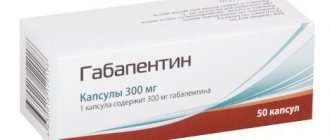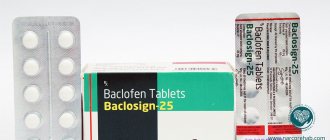Pharmacological properties of the drug Fentanyl
fentanyl is a phenylpiperidine derivative (partially similar to trimeperidine), belongs to the group of narcotic analgesics. It has a strong (short-term when administered once) analgesic effect. Its analgesic activity is almost 100 times greater than that of morphine. The mechanism of action is due to inhibition of the thalamic centers of pain sensitivity and blocking the transmission of pain impulses to the cerebral cortex. Stimulates the vomiting center and the nucleus of the vagus nerve. When administered in high doses, it can cause short-term, mild respiratory depression. After intravenous administration of fentanyl, the maximum effect is observed after 1–3 minutes and lasts 15–30 minutes. After intramuscular administration, the maximum analgesic effect develops within 3–10 minutes.
Fentanyl - what is it?
Fentanyl is an opioid analgesic used in anesthesiology.
Long-term use of fentanyl solution or tablets is fraught with the development of drug addiction. Today, the drug fentanyl, as well as its various derivatives, are among the most powerful synthetic drugs. The drug fentanyl comes in the form of a white crystalline powder or liquid solution for injection. It was first received by Paul Janssen in 1959. Soon after this, the drug began to be used in medicine as a highly effective pain reliever, replacing some non-narcotic analgesics. In the 90s of the last century, a patch made on the basis of this substance appeared on the market. It was intended to relieve point pain following injuries. Soon, doctors noticed that those patients who were administered fentanyl began to develop dependence on it and experienced withdrawal symptoms. Therefore, restrictions were placed on the distribution of this substance. Some countries have completely banned its use.
Fentanyl Addiction Treatment
consultation with a narcologist at home and in hospital
withdrawal symptoms
We work around the clock
Free consultation Leave a request and we will call you back in 1 minute
8
Or call
Use of the drug Fentanyl
IM and IV. For adults, for premedication before anesthesia or for analgesia in the postoperative period, fentanyl is administered intramuscularly at a dose of 0.05–0.1 mg. For induction anesthesia, a dose of 0.1–0.2 mg is administered intravenously. For neuropeptanalgesia, fentanyl is administered intravenously at a dose of 0.2–0.6 mg; this dose should be administered in parts, depending on the individual sensitivity of the patient, if possible under control of the respiratory rate. Additional doses of fentanyl should be administered approximately every 20 minutes. Higher doses (0.05–0.1 mg/kg) are used for open heart surgery. Patch (TTS) - for 72 hours, apply to a flat surface of the skin (non-irritated with minimal hair, washed with water if necessary, without using detergents and thoroughly dried) and pressed tightly. Places of application are alternated, the dose is selected individually. For premedication before surgery, fentanyl is administered to children intramuscularly at a dose of 0.002 mg/kg 30–60 minutes before surgery; fentanyl in the same dose is used for analgesia in the postoperative period. For induction of anesthesia and maintenance of general anesthesia, it is administered intravenously at a dose of 0.002 mg/kg or intramuscularly at a dose of 0.0015–0.0025 mg/kg.
Fentanyl
Patients experiencing severe side effects should be closely monitored for at least 24 hours (depending on symptoms) after removal of Fentanyl TTC, as fentanyl plasma concentrations decrease gradually and a 50% reduction is achieved within approximately 17 (13- 22) hours.
Fentanyl TTC should be kept out of the reach of children both before and after use.
Fentanyl TTC cannot be cut.
Application
in
opioid-naïve patients who are not opioid-tolerant
When using Fentanyl TTC in opioid-naïve patients, significant respiratory depression and/or death have been reported very rarely when used as initial opioid therapy. The potential for severe or life-threatening hypoventilation exists even when a minimal dose of Fentanyl TTC is used as initial opioid therapy in opioid-naïve patients. It is recommended to prescribe Fentanyl TTC to patients demonstrating opioid tolerance.
Respiratory depression
As with other narcotic analgesics, significant respiratory depression may occur in some patients when using Fentanyl TTC. Patients should be carefully monitored for such effects. Respiratory depression may continue after removal of the TTS. The degree of respiratory depression increases with increasing dose of Fentanyl TTC. Medicines that affect the central nervous system may increase respiratory depression.
Chronic lung diseases
Fentanyl can cause a number of severe side effects in patients with chronic obstructive pulmonary disease and other pulmonary diseases. In these patients, opioids may decrease respiratory excitability and increase respiratory resistance.
Increased intracranial pressure
Fentanyl TTC should be used with caution in patients who may be particularly sensitive to elevated CO2 levels. Such patients are those who have experienced increased intracranial pressure, impaired consciousness, or coma. Fentanyl TTC should be used with caution in patients with brain tumors.
Diseases of the cardiovascular system
Fentanyl may cause bradycardia and should therefore be used with caution in patients with bradyarrhythmias. Fentanyl TTS should be used with caution in patients with arterial hypotension.
Liver failure
Because fentanyl is metabolized to inactive metabolites in the liver, impaired liver function may result in delayed elimination of the drug. Patients with hepatic impairment taking Fentanyl TTC should be closely monitored for symptoms of possible fentanyl toxicity, and the dose of Fentanyl TTC should be reduced if necessary. Opioid analgesics can increase the tone of the smooth muscles of the gastrointestinal tract and biliary tract.
Fentanyl TTC should be used with caution in patients with a history of hepatic colic.
Kidney failure
Less than 10% of fentanyl is excreted unchanged by the kidneys, and fentanyl has no known active metabolites that are excreted by the kidneys. Patients with renal impairment taking Fentanyl TTC should be closely monitored for symptoms of possible fentanyl toxicity and the dose of Fentanyl TTC should be reduced if necessary.
Serotonin syndrome
Caution should be exercised when co-administering Fentanyl TTC with drugs that affect the serotonergic neurotransmitter system. Concomitant use with serotonergic drugs such as selective serotonin reuptake inhibitors (SSRIs) and serotonin norepinephrine reuptake inhibitors (SNRIs), as well as drugs that reduce serotonin metabolism (including MAO inhibitors), may lead to the development of potentially life-threatening serotonin syndrome. This syndrome may occur when taking recommended doses.
Serotonin syndrome may include psychiatric disorders (agitation, hallucinations, coma), autonomic disorders (tachycardia, blood pressure fluctuations, hyperthermia), neuromuscular disorders (hyperreflexia, incoordination, rigidity) and/or gastrointestinal disorders (nausea, vomiting, diarrhea) .
If the development of serotonin syndrome is suspected, therapy with Fentanyl TTC should be discontinued.
Interaction with inhibitors of cytochrome
CYP3A4 When CYP3A4 ,
an increase in the concentration of fentanyl in plasma is possible. The consequence of this is an increase or prolongation of both the therapeutic effect and possible side effects (respiratory depression). In these cases, the patient should be under constant medical supervision.
Therefore, the concomitant use of transdermal forms of fentanyl with inhibitors of cytochrome CYP3A4 is not recommended, unless patients are under medical supervision. If symptoms of depressed breathing occur, the dose of the drug should be reduced.
Accidental exposure to TTC
Accidental skin exposure (especially in children) to Fentanyl TTC through close physical contact with a patient using TTC may result in opioid overdose. Patients should be warned that in case of accidental exposure to the skin of a person not taking the drug, TTS should be removed immediately. For symptoms of overdose, see section "Overdose".
Use in elderly patients
Data from studies of intravenous fentanyl suggest that elderly patients will have decreased clearance and prolonged half-life and may be more sensitive to fentanyl than younger patients. Elderly patients taking Fentanyl TTC should be closely monitored for symptoms of possible fentanyl overdose and, if necessary, the dose of Fentanyl TTC should be reduced.
Effect on the gastrointestinal tract
Opioids increase the tone and reduce propulsive contractions of the smooth muscles of the gastrointestinal tract. As a result, gastrointestinal transit time increases, which can cause constipation. Patients should be informed about measures to prevent constipation and the prophylactic use of laxatives. Additional precautions should be taken in patients suffering from chronic constipation. If paralytic ileus is present or suspected, treatment with Fentanyl TTC should be discontinued.
Application
in
depleted and debilitated patients
Since clearance may be reduced in depleted and debilitated patients and the half-life of the drug may be prolonged, depleted and debilitated patients should be under constant medical supervision to identify symptoms of a possible overdose, in which case the dose of Fentanyl TTC should be reduced.
Drug dependence and potential for abuse
With repeated administration of opioids, tolerance and physical and psychological dependence can develop. Iatrogenic dependence with opioid use is rare.
As with other opioid agonists, there is a potential for abuse of fentanyl. Abuse or intentional misuse of Fentanyl TTC can lead to overdose and/or death. Patients at increased risk for opioid abuse may still receive adequate treatment with modified-release narcotic analgesics but should be closely monitored for possible signs of off-label use, abuse, or dependence.
Fever / external heat sources
A pharmacokinetic model suggests that serum fentanyl concentrations may increase by approximately one-third if body temperature rises to 40°C. Therefore, patients with fever should be closely monitored for opioid-specific side effects and subsequent dose adjustments if necessary. There has been an increase in the release of fentanyl from TTS with increasing temperature, which can result in overdose and death of the patient. A study on healthy volunteers showed that when heated with fentanyl TTC, there was an increase in mean AUC values by 120% and Cmax by 61%. All patients should avoid direct exposure of the Fentanyl TTC application site to external heat sources, such as heat lamps, tanning lamps, intense sunbathing, heating pads, saunas, solariums, hot water baths, etc.
Discontinuation of the drug
If it is necessary to discontinue the use of Fentanyl TTC, replacing this drug with other opioids should be done gradually, starting with low doses. This drug change regimen is necessary because fentanyl concentrations gradually decrease after TTC removal, with a 50% reduction in serum fentanyl concentrations taking 17 hours. Withdrawal of opioid analgesia should always be gradual to prevent the development of a withdrawal syndrome.
Instructions for disposal of Fentanyl TTS
Unused TTS must be returned to the attending physician for disposal. Used TTS should be folded in half with the sticky side inward and disposed of independently.
Special instructions for the use of the drug Fentanyl
fentanyl has a short-term effect, but not due to rapid breakdown and elimination, but as a result of high lipid solubility and the so-called distribution effect. Therefore, in cases where the administration of fentanyl is repeated during prolonged anesthesia, its prolonged effect may be observed; Sometimes a rebound effect is also observed, so after the end of surgery the patient's condition must be strictly monitored. If muscle stiffness occurs, causing difficulty breathing, the use of muscle relaxants and mechanical ventilation may be required. Delayed recovery from anesthesia or respiratory depression following a relative or absolute overdose of fentanyl can be reversed by administering naloxone. Bradycardia can be corrected or prevented by administration of atropine. In the absence of conditions for mechanical ventilation, the use of fentanyl is unacceptable.
The effect of fentanyl
The following types of effects of fentanyl on the body can be distinguished:
- sedative effect;
- feeling of euphoria;
- slow heart rate;
- depression of the respiratory center;
- pronounced analgesic, etc.
How to recognize a fentanyl addict?
This drug is most often used intravenously, as evidenced by needle marks on the skin. The following symptoms also indicate the use of this substance:
- constricted pupils that do not respond to light;
- slow breathing;
- causeless fun, constantly high spirits;
- speech disorders;
- drowsiness, causeless fatigue;
- lethargy, apathy;
- decreased or complete lack of appetite.
Symptoms of using this drug depend on the stage of drug intoxication. For several hours after taking this drug, a person is in high spirits, enjoys every little thing, and laughs for no reason. After a few hours, when fentanyl stops working, the euphoria gives way to depression, depressed mood and apathy. It is not uncommon for drug addicts to develop psychosis after taking this drug. Call 8 (495) 150-85-96











